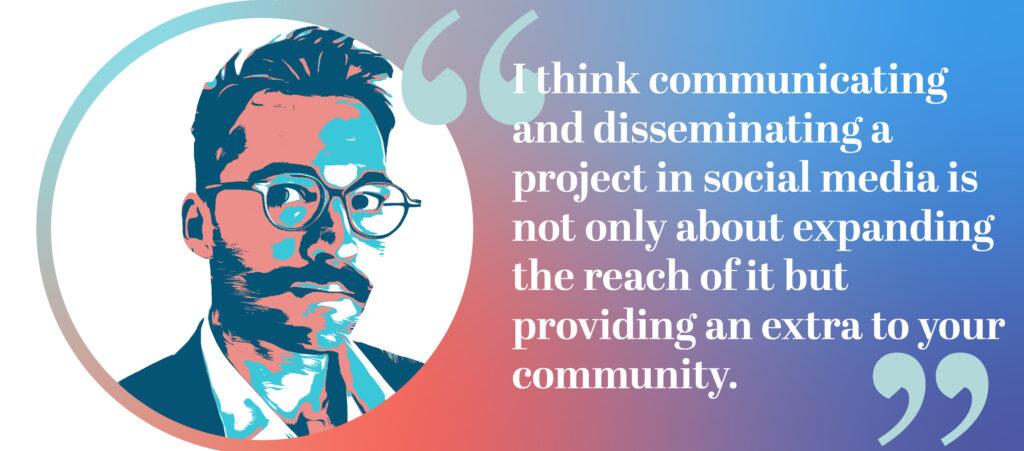Interview to Juan Manuel Hegedüs, Communication Manager of the project Charter – Best Social Media Activity winner – #SocialEU Award 2021
The Charter project impressed us for the presence on almost all the social media platforms with a high quality of dissemination. This reveals the presence of a dedicated dissemination team. How does this influence the choice of which channel to use and on the dissemination strategy?
This brings an important point to the table which is the resources available to agree on a dissemination strategy. It’s important at the very start to have a clear idea of the human resources, budget and days available to work on the communication and dissemination of the project in order to have a match between the strategic plan and the capacity to manage it. This will vary from project to project, but it’s key to select which channels and the level of dissemination on them accordingly. In our case, both the Coordination of the project and ENCATC decided to give the communication and dissemination dimension a big space to ensure the project’s outreach. For this purpose, we have selected the four main social media channels, Facebook, Twitter, LinkedIn and Instagram. The treatment of each is different as they differ on their targets and their potential outcomes.
Charter’s posts are graphically accurate and visually catchy. How important is it for you to work on the visual impact of communication?
This is very important and was set on the plan from the beginning. As communicators, we know we are dealing with an environment full of messages and information coming back and forth. The chances to get the attention of our community are few, so we need to make the best of it. Visual resources are key to increase the chances of having a user stop for a second and decide to read and interact with the content you put out there. Good practices recommendations have pointed this out some years ago and the trend is still very much present. This not only relates to including pictures, gifs or videos, but systematically using icons to make yourself visible in the feed. For instance, we always use the blue dot to start (following our institutional colors) to be quickly identified when the very fast scrolling-down takes place!
Despite your experience in working on social media, what is your favourite or more effective platform to disseminate EU projects between Facebook, Twitter, Instagram and LinkedIn?
It’s hard to say when each of them provides you with different results, which combined are very good and diverse for the communication. Anyways, I would suggest this depends on the nature of the message/content to be shared. For instance, when publishing a report of a project, we need to ensure a simple and clear presentation of what this offers to our community, at the same time of giving sufficient and qualitative information about what’s about. In these cases, I would say LinkedIn and Facebook are the best channels. And we can see our followers appreciate reading a bit more to fully grasp what our communication is about. But these platforms are not good for the high-speed communication of events, from my point of view. Twitter provides the most agile nature for this, giving swift updates that can be useful for users to follow the main points and activities taking place. For this reason, my final comment would be the value is on the mix and not the individuality of tools!
In your experience, is the decision about which social media to use influenced by the competencies and the contribution of the partnership?
Not in our case. The role of the communication manager of the project should include these competences and provide such expertise. I would say that in the partnership you will find the resources, such as publications, knowledge, contents, to later transform and adapt to the social media environment. This is something to be fostered and encouraged to have a dynamic communication later. When specific dissemination activities take place, the communication group prepares guidelines, usually in the format of a dissemination kit, to help partners contribute on an efficient and simple way. I would also suggest the communication manager should have contact with the different communication officers in the partnership to ensure higher possibilities of dissemination.
Is someone in the project working specifically in the management of social media and who has some formation on it? How many people are working in the dissemination of this project and how many hours per week do they work exclusively on this project?
For CHARTER, I’m in charge of managing the social media in name of ENCATC. I have a degree in Communications and a postgraduate title in Digital Marketing & Inbound Marketing, where I deepened my knowledge in digital communications and content creation. Additionally, I have worked professionally as Community Manager in the past. The dissemination team of CHARTER is led by ENCATC with the co-leadership of NEMO. I dedicate daily hours to communication, dissemination and support/coordination of communication aspects with other working packages.
Talking about posting on social media, could you explain how you control the statistics and reports, do you think it is important to control statistics to adjust the editorial plan?
We have different reports we follow to make sure the overall strategy works and that our social media is healthy. By healthy I mean that the overall result of our actions shows a stable growth rate in terms of followers and that the engagement rate is appropriate: what we put out there has a response and appreciation by our followers. I’m happy to say that CHARTER has very good results in this sense. In comparison with other EU blueprints, we’re number 1 on Facebook and LinkedIn in terms of followers; and our Twitter growth rate for intervals of 6 months is always around 40%-50%. In terms of engagement, all of our social media channels combined result in 8% of engagement, which is a very high number if we consider that organisations and brands work hard to be around 3%-5%.
Statistics are key to work in communications. Numbers speak for themselves and give you clear message of how your strategy is going. We follow the official channels to monitor our metrics, and this plays an important role in how we proceed. As the project developed, we have seen certain contents to be more effective than others, and by repetition, in some cases, confirmed certain type of contents are a “must” for us. At the same time, we have identified those types of communications which were not useful and didn’t have good results. I would say communication managers need to process and transform all these metrics into official criteria and actions to ensure ROI. At the same time, this is the exciting part of working in communications! You can plan, test, modify and see what works best for your audience in real time!
What tip would you give to someone who wants to use social media in the dissemination of a European Project?
My advice is to really take time to reflect about your project’s subject and conduct an extensive benchmark of what’s being done in the field. This will already give you a lot of clues and parameters to be able to provide something new and different. I would say both things combined will result in a good plan to start, that you should discuss with experts to get more insights and make necessary amendments. I think communicating and disseminating a project in social media is not only about expanding the reach of it but providing an extra to your community. You need to find a way in which you can balance your obligations to your project and what the users appreciate while browsing the feed walls. I think we have reached a point in which standard referential communications are quickly identified by users and will be hardly catch their attention and engage them. At the same time, social media channels are the privileged space to follow the life of a project, organisation or brand. If you can elaborate a content strategy to do so adding a differential value, you will probably be off to a good start!

